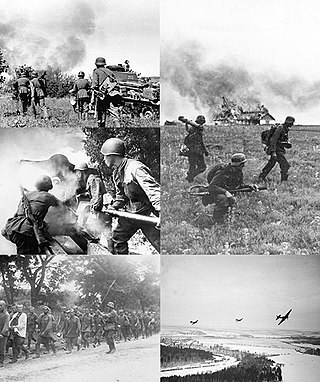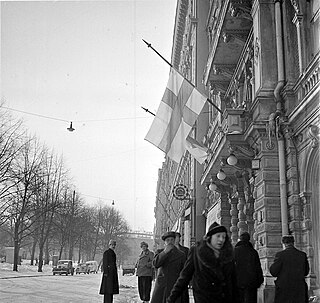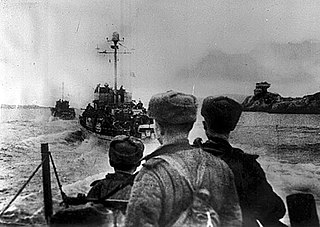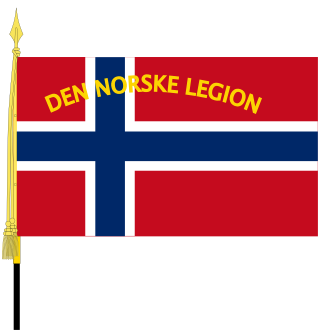
The Continuation War, also known as the Second Soviet-Finnish War, was a conflict fought by Finland and Nazi Germany against the Soviet Union during World War II. It began with a Finnish declaration of war and invasion on 25 June 1941 and ended on 19 September 1944 with the Moscow Armistice. The Soviet Union and Finland had previously fought the Winter War from 1939 to 1940, which ended with the Soviet failure to conquer Finland and the Moscow Peace Treaty. Numerous reasons have been proposed for the Finnish decision to invade, with regaining territory lost during the Winter War regarded as the most common. Other justifications for the conflict include Finnish President Risto Ryti's vision of a Greater Finland and Commander-in-Chief Carl Gustaf Emil Mannerheim's desire to annex East Karelia.

Operation Barbarossa was the invasion of the Soviet Union by Nazi Germany and many of its Axis allies, starting on Sunday, 22 June 1941, during the Second World War. It was the largest land offensive in human history, with around 10 million combatants taking part. The operation, code-named after Frederick Barbarossa, a 12th-century Holy Roman Emperor and Crusader, put into action Nazi Germany's ideological goal of conquering the western Soviet Union to repopulate it with Germans. The German Generalplan Ost aimed to use some of the conquered people as forced labour for the Axis war effort while acquiring the oil reserves of the Caucasus as well as the agricultural resources of various Soviet territories, including Ukraine and Byelorussia. Their ultimate goal was to create more Lebensraum for Germany, and the eventual extermination of the native Slavic peoples by mass deportation to Siberia, Germanisation, enslavement, and genocide.

Operation Arctic Fox was the codename given to a World War II campaign by German and Finnish forces against Soviet Northern Front defenses at Salla, Finland in July 1941. The operation was part of the larger Operation Silver Fox which aimed to capture the vital port of Murmansk. Arctic Fox was conducted in parallel to Operation Platinum Fox in the far north of Lappland. The principal goal of Operation Arctic Fox was to capture the town of Salla and then to advance in the direction of Kandalaksha to block the railway route to Murmansk.

Operation Silver Fox from 29 June to 17 November 1941, was a joint German–Finnish military operation during the Continuation War on the Eastern Front of World War II against the Soviet Union. The objective of the offensive was to cut off and capture the key Soviet Port of Murmansk through attacks from Finnish and Norwegian territory.
Mountain Corps Norway was a German army unit during World War II. It saw action in Norway and Finland.

Finland participated in the Second World War initially in a defensive war against the Soviet Union, followed by another, this time offensive, war against the Soviet Union acting in concert with Nazi Germany and then finally fighting alongside the Allies against Germany.

The matter of German troop transfer through Finland and Sweden during World War II was one of the more controversial aspects of modern Nordic history beside Finland's co-belligerence with Nazi Germany in the Continuation War, and the export of Swedish iron ore during World War II.

Non-Germans in the German armed forces during World War II were volunteers, conscripts and those otherwise induced to join who served in Nazi Germany's armed forces during World War II. In German war-time propaganda those who volunteered for service were referred to as Freiwillige ("volunteers"). At the same time, many non-Germans in the German armed forces were conscripts or recruited from prisoner-of-war camps.
Operation Platinum Fox was a German and Finnish military offensive launched during World War II. Platinum Fox took place on the Eastern Front and had the objective of capturing the Barents Sea port of Murmansk. It was part of a larger operation, called Operation Silver Fox.

The Battle of Petsamo was fought between Finnish and Soviet troops in the area of Petsamo in the far north of Finland in 1939 and 1940. The Finnish troops were greatly outnumbered but managed to contain the Soviet troops due to the extreme terrain, weather and leadership.

The Interim Peace was a short period in the history of Finland during the Second World War. The term is used for the time between the Winter War and the Continuation War, lasting a little over 15 months, from 13 March 1940 to 24 June 1941. The Moscow Peace Treaty was signed by Finland and the Soviet Union on 12 March 1940 and it ended the 105-day Winter War.

The Petsamo–Kirkenes offensive was a major military offensive during World War II, mounted by the Red Army against the Wehrmacht in 1944 in the Petsamo region, ceded to the Soviet Union by Finland in accordance with the Moscow Armistice, and Norway. The offensive defeated the Wehrmacht's forces in the Arctic, driving them back into Norway, and was called the "Tenth Shock" by Stalin. It later expelled German forces from the northern part of Norway and seized the nickel mines of Petsamo.

The Finnish invasion of East Karelia was a military campaign in 1941. It was part of the Continuation War. Finnish troops occupied East Karelia and held it until 1944. For over a month after the outbreak of the Continuation War, the Karelian Army reinforced and prepared to resume its earlier offensive while waiting for the recapture of the Karelian Isthmus. The Soviets had prepared fortifications and brought troops to the front. When encirclements on the western shore of Lake Ladoga were resolved, the Finnish 7th Division was transferred to the junction of VI and VII Corps.
The 14th Army was a field army of the Soviet Army, formed twice.

During World War II, the Lapland War saw fighting between Finland and Nazi Germany – effectively from September to November 1944 – in Finland's northernmost region, Lapland. Though the Finns and the Germans had been fighting together against the Soviet Union since 1941 during the Continuation War (1941–1944), peace negotiations between the Finnish government and the Allies of World War II had been conducted intermittently during 1943–1944, but no agreement had been reached. The Moscow Armistice, signed on 19 September 1944, demanded that Finland break diplomatic ties with Germany and expel or disarm any German soldiers remaining in Finland.

Operation EF (1941), also the Raid on Kirkenes and Petsamo took place on 30 July 1941, during the Second World War. After the beginning of Operation Barbarossa, the German invasion of the Soviet Union on 22 June 1941, Fleet Air Arm aircraft flew from the aircraft carriers HMS Victorious and Furious to attack merchant vessels in the northern Norwegian port of Kirkenes and the north Finnish port of Liinakhamari in Petsamo.

Norwegian Legion was a Norwegian collaborationist formation of the Waffen-SS during World War II. It was formed in German-occupied Norway on 29 June 1941, in support of the war aims of Nazi Germany. The unit was disbanded in 1943.

The Liberation of Finnmark was a military operation, lasting from 23 October 1944 until 26 April 1945, in which Soviet and Norwegian forces wrested away control of Finnmark, the northernmost county of Norway, from Germany. It started with a Soviet offensive that liberated Kirkenes.
Ernst Klink was a German military historian who specialised in Nazi Germany and World War II. He was a long-term employee at the Military History Research Office (MGFA). As a contributor to the seminal work Germany and the Second World War from MGFA, Klink was the first to identify the independent planning by the German Army High Command for Operation Barbarossa.














